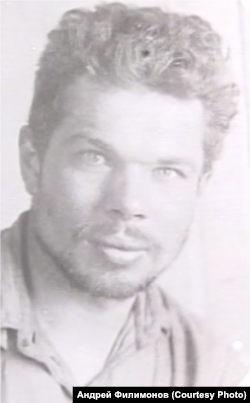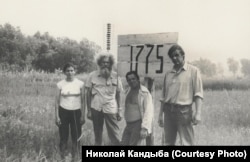TOMSK, Russia – Every year, a small group of locals travels the 550 kilometers northwest from this Siberian city to Nazinsky Island, in the middle of the Ob River, to place a wreath at the foot of a wooden cross. It is a gesture of remembrance for the victims of the horrific events that unfolded there in the summer of 1933.
"Every year in June, we place a wreath at the cross that was placed on the island in 1993," Valeria Shtatolkin told RFE/RL. "But this year, we couldn't go. The water was too high, and the island is almost entirely flooded."
Their dedication to the pilgrimage is part of an effort to remind fellow Russians of an experiment in social engineering and self-sufficiency that went tragically wrong for many of the "settlers" lured by Soviet authorities under Josef Stalin -- whose brutal excesses have frequently been downplayed under Russia's current leadership in favor of a more forgiving historical interpretation of Stalin's three-decade rule.
Eighty-five years ago in May, a small flotilla of lumber barges pulled up to Nazinsky Island and off-loaded about 3,000 "settlers" with orders to construct a "special settlement," as their little corner of Stalin's GULAG – the network of labor camps that spread across the Soviet Union where millions of people were repressed and killed -- was euphemistically called. At least 23 of the prisoners were already dead.
Without tools or shelter or food and surrounded by armed guards who shot anyone who tried to brave the icy river, the prisoners quickly fell victim to starvation, disease, violence, and the brutal elements. And still, additional barges continued to pull up at the island.
Numerous gruesome incidents of cannibalism were reported. So many, in fact, that locals came to call it Cannibal Island or the Island of Death.
By August, at least 4,000 people were dead or missing. According to a Soviet document dated August 20, 1933, there were only 2,200 survivors out of the 6,700 prisoners who had been sent to Nazinsky, a low-lying, swampy strip some 3 kilometers long and about 600 meters wide.
Only 300 of those survivors were deemed at the time fit for further work.
"Once a woman from the Island of Death was brought to our house," Feofila Bylina, a resident of the village of Nazino on the north bank of the Ob, recalled in an oral history in 1989. "She was being taken to another camp.... The woman was taken into the back room to spend the night and I saw that her calves had been cut off. I asked and she said, 'They did that to me on the Island of Death – cut them off and cooked them.' All the meat on her calves was cut away. Her legs were freezing because of this and she wrapped them up with rags. She was able to move on her own. She looked like an old woman, but really she was just a little over 40."
The Nazinsky tragedy was the product of pitiless Soviet efficiency.
One was asked if he ate "human meat." "No, that is not true," he answered. "I only ate livers and hearts."
Secret police head Genrikh Yagoda and Matvei Berman, head of the GULAG system, dreamed up a brutal social-engineering project aimed at "resettling" at least 2 million people in the remote reaches of Siberia and Soviet Kazakhstan. The idea was that the "settlers" would bring millions of hectares of land into cultivation and develop self-sufficient communities within two years. In part, the plan was aimed at covering up the ongoing famine in Ukraine and other parts of the country.
To generate "settlers," the government reinstated the hated system of domestic passports that had been banned after the 1917 Bolshevik coup.
Almost immediately, police throughout the country began rounding up anyone found in a place other than where they were registered.
"'How did you end up here?' we asked one young man," recalled Bylina in her oral history. "He said: 'I didn't do anything. I was a student in Moscow. On the weekend, I went to visit my aunt, who lives in Moscow. I got to her apartment and knocked on the door, but before she opened the door, they grabbed me right there. I was arrested because I didn't have my passport with me.'"
Vera Panovaya, a resident of the village of Ust-Tyma who also gave an oral history in 1989, recalled meeting a man named Kuzma Salnikov, who had been on Cannibal Island.
"He was a miner from Novokuznetsk. Married, with two children. Once he went to Novosibirsk and stopped at the central market," Panovaya recalled. "At that moment, they surrounded the market, set up a dragnet, and arrested everyone who wasn't carrying documents. Everyone – including women and children – was loaded onto a barge and sent to Nazinsky Island."
"There was no food," she continued. "People were tortured by hunger. The guards threw them bits of bread as they passed the island. If you got a piece, you ate. The rest had nothing.... Salnikov was there, but he managed to escape. He swam the river and made it through the swamps to a village. After that, he worked on a collective farm."
The police, however, worked too quickly. When the first 25,000 people arrived in Tomsk in April 1933, their camp had not been built. Prisoners continued to collect, but they could not be transported further on because the Ob and Tom rivers were still iced over.
After getting the ration, the people ran to the water and mixed it with the flour in their hats and ate it. Many people just ate the flour as it was, and since it was a powder, many suffocated from breathing it in."
As was standard practice in Stalin's GULAG, common criminals were mixed in among the political prisoners as a means of maintaining an atmosphere of terror.
Soviet documents preserved in the GULAG museum in Tomsk record the interrogations of some of these criminals who were at Nazinsky Island.
One was asked if he ate "human meat."
"No, that is not true," he answered. "I only ate livers and hearts."
Asked for details, he said: "It was very simple. Just like shashlik. We made skewers from willow branches, cut it into pieces, stuck it on the skewers, and roasted it over the campfire."
"I picked those who were not quite living, but not yet quite dead," he added. "It was obvious that they were about to go – that in a day or two, they'd give up. So it was easier for them that way. Now. Quickly. Without suffering for another two or three days."
Others described women who were tied to trees while men cut off their breasts, calves, and other body parts.
Another common criminal whose interrogation survives bragged of beating prisoners to extract the gold in their dental work.
"In order to get smokes," he said, when asked why he did it. "People need to smoke. From the guards, you could get a matchbook [of tobacco] or two whole newspapers for rolling cigarettes."
The disaster on Cannibal Island was so horrifying that a local communist instructor named Vasily Velichko set out on his own initiative to investigate in July 1933. He interviewed dozens of people and wrote an 11-page report that he sent to Moscow, Novosibirsk, and the district center Narym. His report was stamped "top secret" and only came to light in 1994.
"People began dying," he wrote. "They burned to death alive while sleeping close to the fires. They died from exhaustion and cold."
"Immediately after the snow and frost came the rains and freezing winds," he continued. "And the people were still left without food. Every fourth or fifth day, some rye flour was brought to the island and distributed to the settlers, a few hundred grams each. After getting the ration, the people ran to the water and mixed it with the flour in their hats and ate it. Many people just ate the flour as it was, and since it was a powder, many suffocated from breathing it in."
Nazinsky Island was finally evacuated in July 1933. When Velichko reached it in August, all the "settlers" were gone.
"The grass on the island was head high," he wrote in his report. "But locals who went there to gather berries returned after discovering corpses in the grass and stick shelters full of skeletons."
In 1989, the Tomsk branch of the Memorial human rights group sent an expedition to Nazinsky to gather oral histories.
"I went there from Tveritinskye to cut hay," Nazino resident Taisia Chokarevaya told the Memorial team about her trip to Nazinsky after the camp had been abandoned. "I saw people washing their hands. I was holding my nose and thinking, 'What are they doing?' They would wash their hands and then run back up. I saw that they were collecting gold teeth.... There was a state store then in Aleksandrovsk. They took the gold there. Anyone who had gold took it there. They had some nice clothes, macaroni, good food."
Velichko's report caused a sensation in Moscow. The Communist Party sent a special commission to Nazino to investigate, and the facts of the report were largely confirmed. Several officials of the former camp were reprimanded and sentenced to prison terms ranging from one to three years. Velichko's report was labeled secret and tucked away in the archives.
Velichko himself was fired from his party job. He later became a journalist and gained some fame as a war correspondent during World War II. He traveled with the Red Army all the way to Berlin.
After the war, he wrote several novels singing the praises of the transformation of Siberia under the Soviet government. He never wrote anything else about Cannibal Island.













